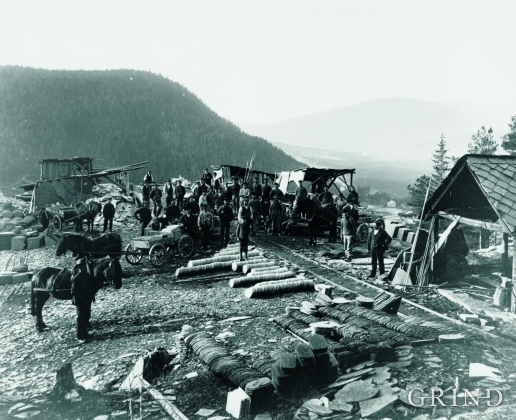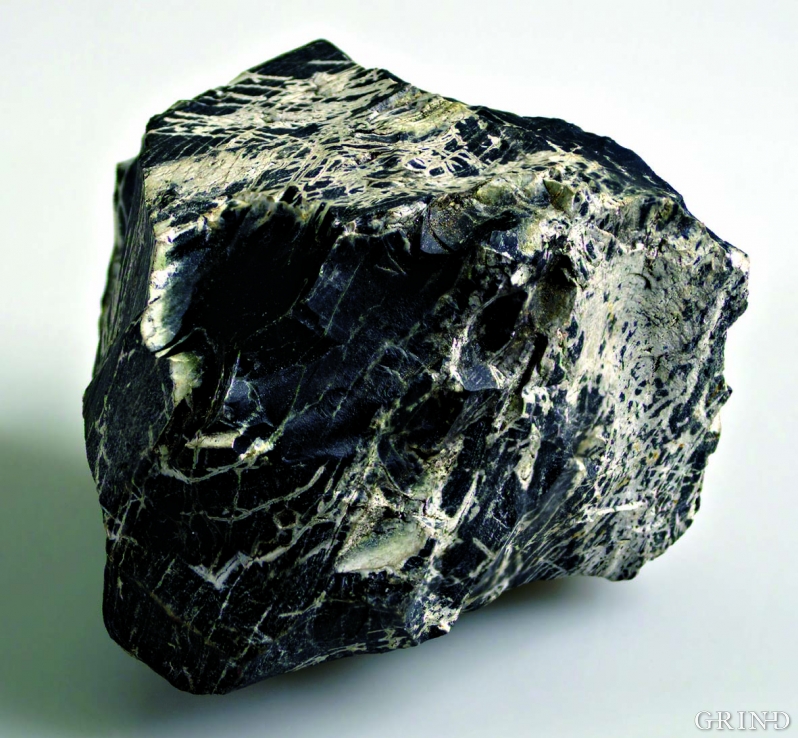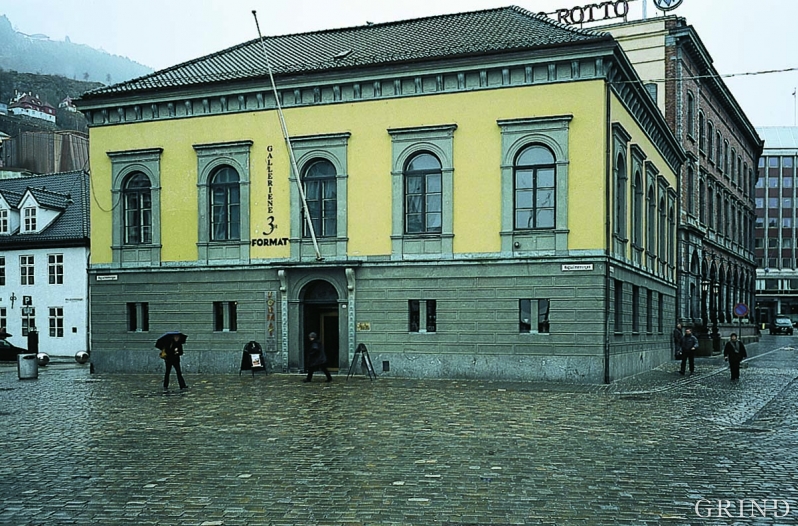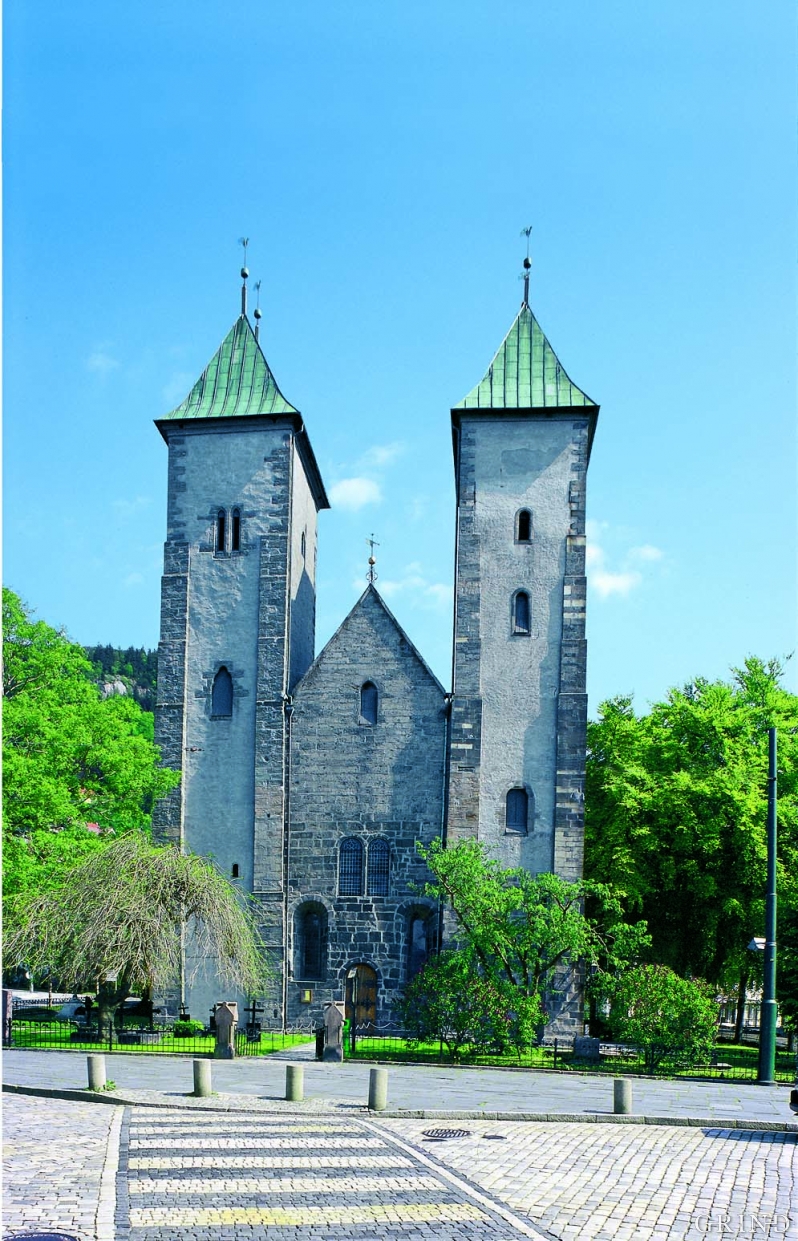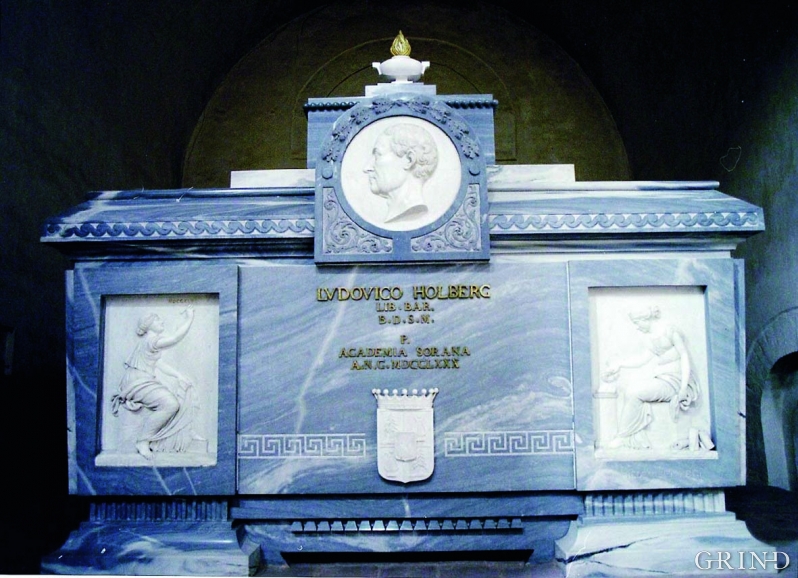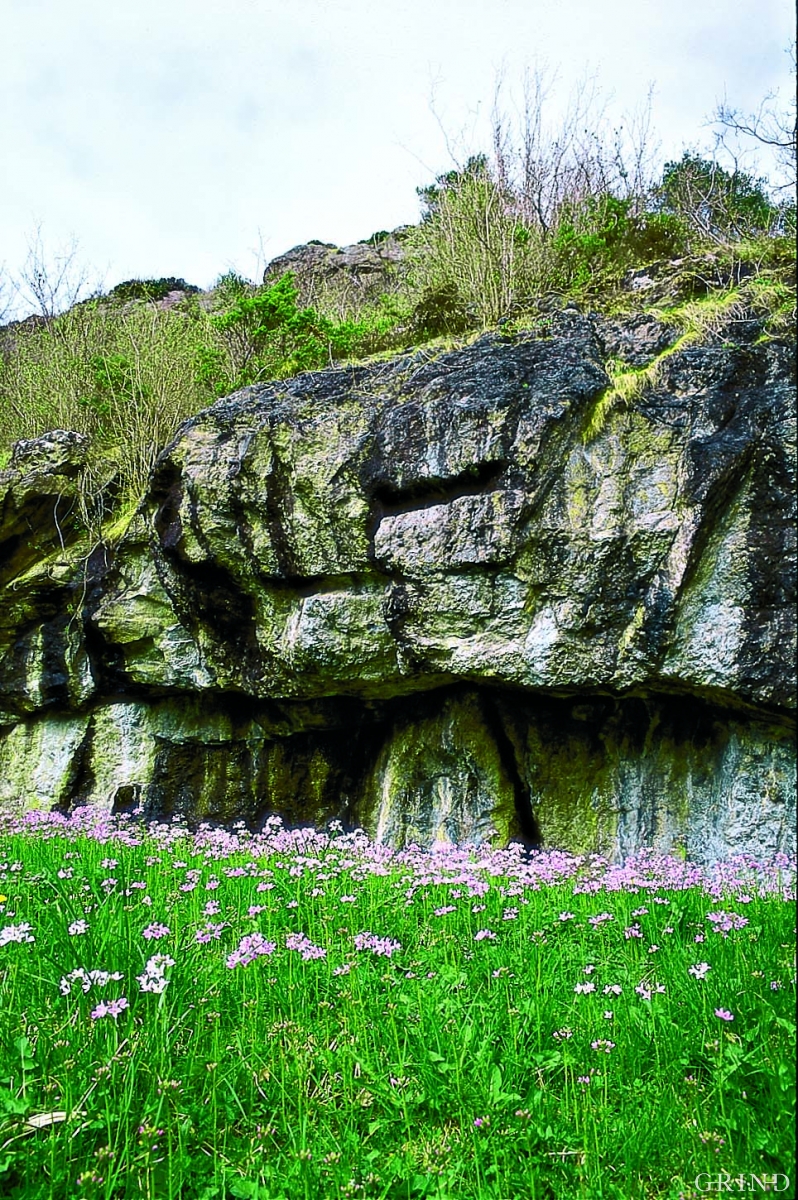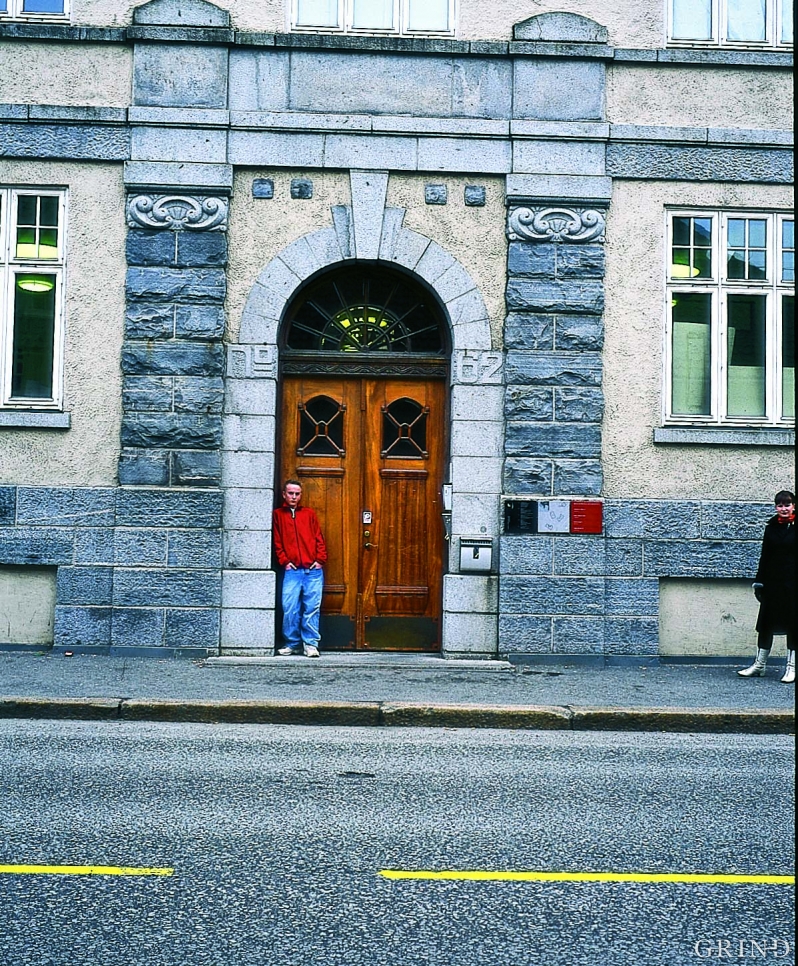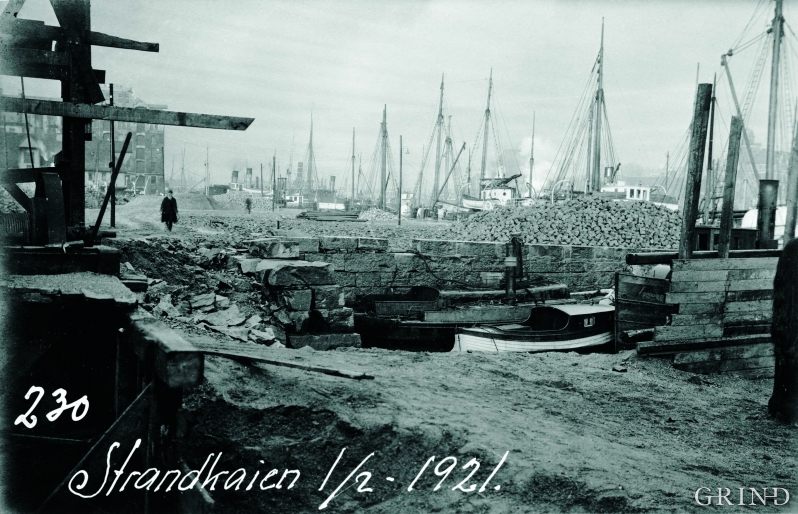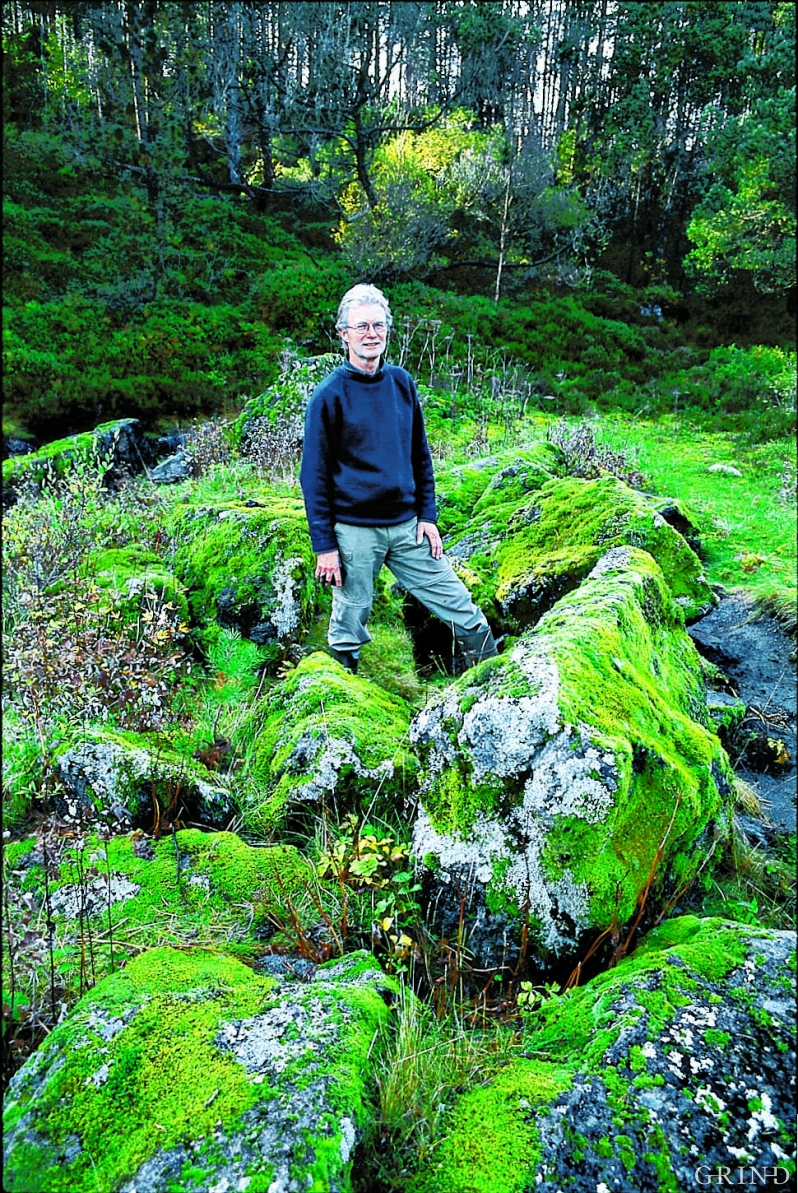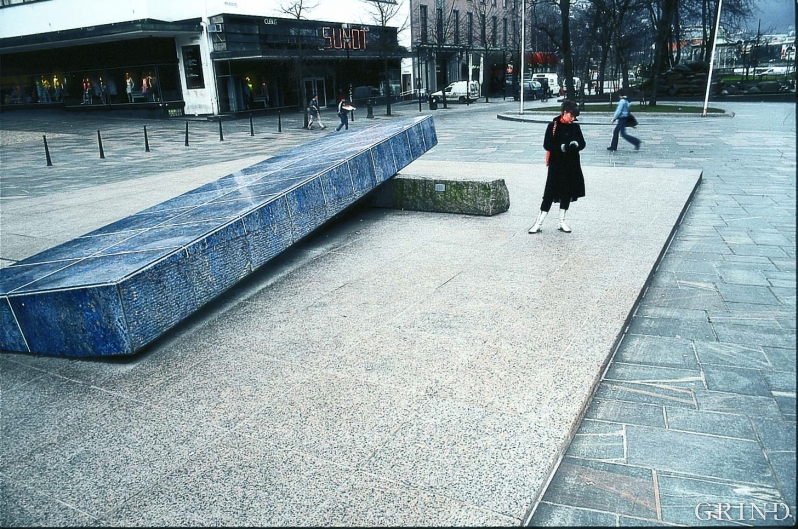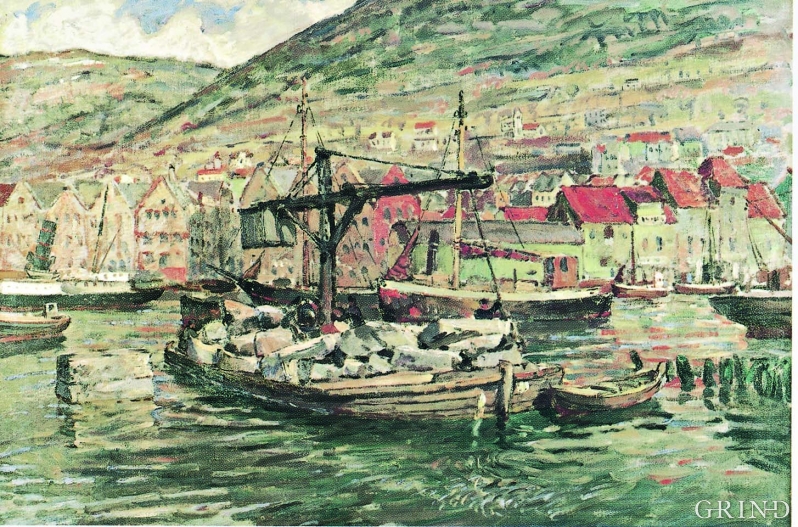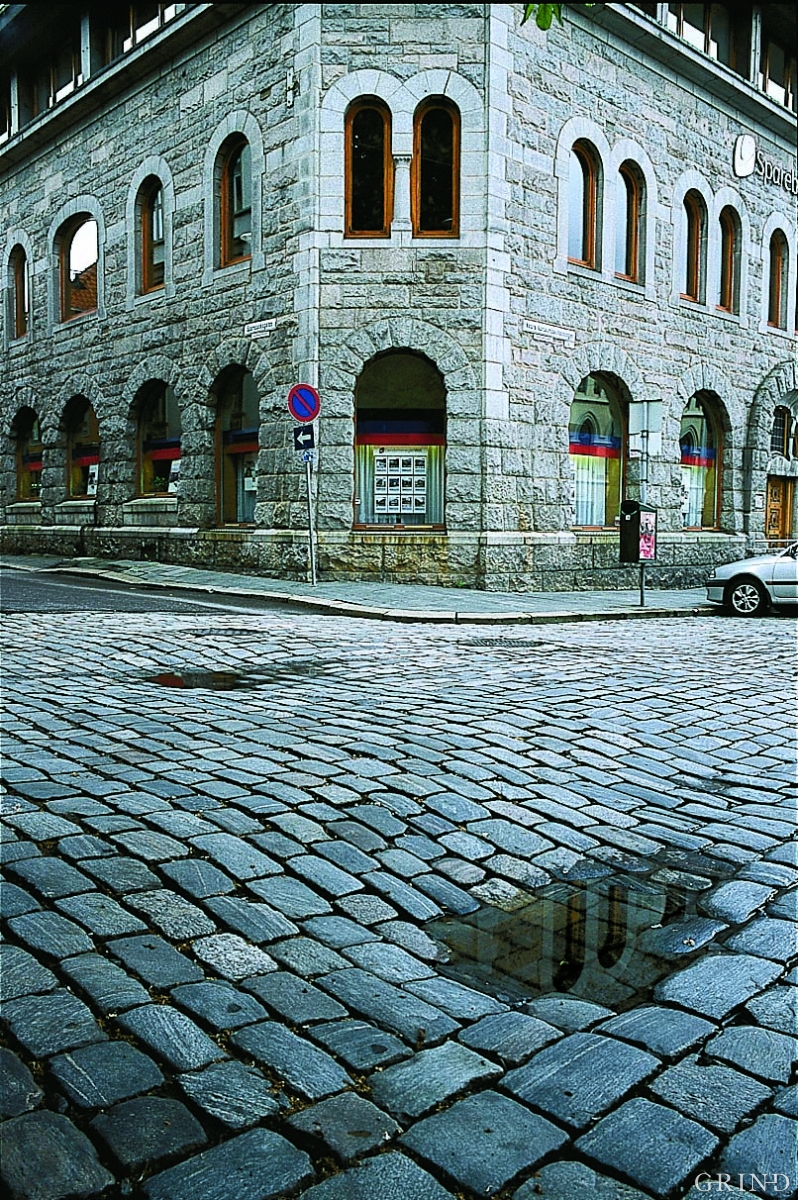Published: 28.10.2004 | Author: Øystein J. Jansen
Takskifer klar til henting. Fra skiferbruddet på Nordheim på Voss, ca.1920. (Per Braaten)
Hordaland has been through several "Stone Ages". The first was in the real Stone Age, with Bømlo as its centre. Hard stone as tools and weapons was the normal occupation for Bømlo folk. The next started a ways into the 1800s. Building stone and cobblestones in the street became popular in cities throughout the country. The last stone age is just about twenty years old - after a long period of dominance by asphalt and cement, natural stone has again become desirable in streets and squares, in roads and as building facades.
The oldest quarry
Greenstone was quarried at Hespriholmen over 7000 years ago (*KHV p. 203), and hard rhyolitic lava was quarried out from Mt. Siggjo for two thousand years starting roughly 4300 years ago (*R270). These quarries made Bømlo the municipality's most important site for materials for making tools and weapons in the oldest times.
Soapstone was also quarried. When material was needed for forming into cooking pans, vessels, weaving weights, casting moulds and fishing net sinkers, it was essential to have a softer type of stone. Soapstone is soft and soap-like, and well suited to such needs. The more shaley variety was in addition used as baking trays. There are many occurrences of soapstone in Hordaland, and we know that many of these were in use from at least 500 B.C.
The Middle Ages - the first stone houses
Before the Middle Ages, stone was only used for building purposes in simple constructions and as foundations for wooden houses. Loose stones from the immediate surroundings were used, and simply stacked one upon another without mortar. When Christianity came to Norway in the year 1000, many of the cloisters and churches were built with stone. This required skills that Norwegians did not have at that time. Stone masons and building masters that followed the churchmen from neighbouring lands comprised the first work immigration to Norway. Many of those who came to Hordaland were from England, but also Sweden, Germany and other countries were represented. The stone work in the church buildings was largely from loose blocks that were found in fields, along beaches and in stone walls. It was probably seldom that stone was quarried out from bedrock for stone work.
For decorative work, however, for window casings and door openings, carved stone blocks for cornerstones and to decorate the stone walls of the most prestigious buildings, stone that could be formed into beautiful ornamentation was needed. The foreign craftsmen were used to working with softer stone from their homelands: sandstone and limestone that could easily be carved. In Norway, especially Hordaland, these types of stone are rare, since harder stone types predominate. Soapstone was the answer - this soft stone was shown to be ideal for the job. This is how the special tradition of using soapstone in buildings, only found in Norway, began. Many of the largest of the original quarries from before the Middle Ages were more or less emptied of rock - at least those near the sea. The quarries we know of - that we assume were in use in the Middle Ages, are found at Lyklingfjorden in Bømlo (*p. R268), in Etne, on Russøy and Bergholmen in Reksteren, Vargavågen and Lysekloster in Os, Kvernes and Ådland in Samnanger (*p. R327), Sævråsvåg in Lindås, Arsvågen in Fusa and in Rosendal.
Marble - for mortar and Danish castles
Marble is a relatively soft rock type, but it was only seldom used as a building stone in the Middle Ages. However, it was an important raw ingredient for mortar, the cement at that time, which stone buildings required in large amounts. In Sunnhordland there is a belt of marble (*p. R295) that spans from Varaldsøy, over the southeastern part of Tysnes with islands Seløy, Storsøy (*p. R282), then on to the little island Hille near Halsnøy and finally to Moster in Bømlo (*p. R270). The marble had to be burned in lime kilns before it could be used. The oldest known kiln, found in Røyksund at Bømlo, is from the 1200s. But, we can assume that lime burning had been going on since the first stone buildings were built in the 1000s.
The tradition of building in stone goes back to the end of the Middle Ages. In the subsequent 300 years very few stone buildings were built - most were instead built with wood. But stone buildings were built in Denmark also at that time. The Danish kings and their architects took an interest in the Norwegian marble as building stone. In 1701, privileges were granted for quarrying marble from the so-called Lillienschioldske marmorverker (= Lillienschioldske marble works) - mainly in Sunnhorland, but eventually also on Marmorøyen in Nordåsvannet and in Korsdalen near Paradis. Most of it went to the Danish king's castle in Copenhagen - little remained in our district. The operation of these quarries was regularly interrupted, and the last were closed down in the first half of the 19th Century.
Slate
The oldest "industrial" slate quarries we know of in Norway are at Solesnes in Jondal municipality (* p.R 495). The earliest documented operation is from the 1400s, but then most for millstones. The slate, often called Hardanger slate, is much used for roofing stone in the district. Otherwise it is mostly used as paving stones - from around 1860 especially in pavements in Bergen. There are many slate quarries in Hordaland, most in Hardanger, Fusa, Kvinnherad, Sveio (*p. R231) and at Voss (*p. R448). Periodically there has been much activity at several of these quarries, but only the ones in Jondal and Voss are still in operation today.
Voss slate characteristically splits into thin plates, which makes it better suited as roof slates than the thicker slates from the other quarries. The quarry at Voss is thought to have been in operation since the end of the 1700s - with up to 500 men employed. The result can be seen throughout the municipality, where most of the many grey slate roofs come from Voss.
The new stone age - mostly gneiss and granite
The stone industry based on hard stone got a new start from 1870 and onward. Carved building stone was then in demand over the whole country - from whole facades to simpler features and carved ornaments. Many of the quarries also delivered cobblestone, for which demand steadily grew.. There was a growing market also for gravestones, door posts and similar smaller products. Demand for wharf stone increased as wooden wharfs were to be replaced with more durable material.
The first wharf stone quarries we know of in our municipality were in Bergen, where hard quartzite was already being taken out of Dragefjellet - and a few decades later at "Rosenberghagen" (presently Øysteins Gate) at Rothaugen. The quartzite, a very hard sandstone, was used mainly in walls - in more or less processed form. There was another stone quarry at Sydneshaugen during the latter half of the 1800s, where gneiss was taken out, among other things for use as cobblestone from around 1860.
The first building-stone quarry that was established outside of Bergen was at Rubbestadneset in Bømlo (*p. R271), where the first stone masons - mostly Swedes - arrived in 1868 to quarry granite for Skoltegrunnsmoloen. Several quarries were established around Innværsfjorden and Urangsvågen during the next decade, as well as a couple of smaller quarries outside of Rolvsnes. Cobblestone was the main product, but we find Bømlo granite also in many elegant buildings in Bergen from this time - and many stone stairways. The quarries were either closed, or operations dramatically reduced, around 1915.
In Austevoll we find many granite quarries in the western part of Huftarøy and on the islands west of these quarries (*p. R307). The first quarry is from the end of the 1880s. Also here, it was mostly Swedes who were employed in the beginning, but eventually more quarries were established and many local people from Austevoll also became stone masons. Austevoll granite was not carved into cobblestone. Much went instead to building stone in Bergen, but also to edging stone for sidewalks - and, not least, to churchyards. Operations declined toward the end of the 1930s, though some individual stone masons continued right up until the 1960s.
Demand for carved stone for buildings in Bergen was greatest in the decades before and after 1900. Granite was delivered from Austevoll and Bømlo, and some was "imported" from eastern Norway. From the end of the 1800s we also find local gneiss, a hard rock type with a characteristic striping or banding, in buildings in Bergen. Gneiss from Skreien in Vaksdal (*p. R438) is seen repeatedly in many of the finest stone buildings, with the railway station from 1913 as its crowning glory. A similar gneiss was also delivered from several quarries on Askøy (*p. R355), an island that is best known for its many wharf stone quarries. Another type of gneiss, called "augen gneiss", was delivered from quarries at Løvstakken and in Hilleren in the 1910s and 1920s.
Soapstone and Marble - again
Interest in soapstone for building purposes declined sharply after the Middle Ages. The soapstone quarries returned to their "original" uses - providing raw materials for cooking pots, baking griddles, etc. Demand for soapstone increased again toward the end of the 1800s, first in connection with restoration work on Middle Age buildings, but eventually also for use in new buildings - right up until the 1930s. Some was collected from older quarries, but eventually these were depleted and new quarries were established. In Hordaland, the quarries on Lurøy, west of Lygra in Lindås (*p. R407), held a dominant position. In 1933 the quarry was flooded and its operation discontinued. A new quarry was established in Fagerbotten at Trengereidfjorden, but toward the end of the 1930s the soapstone epoch came to an end.
Lime-burning continued also after the Middle Ages, and a lot of marble was taken out from Sunnhordland for this purpose. A large marble quarry was established at Skaftå on Osterøy in 1868. The use of cement took hold towards the late 1800s, but lime-burning continued also into the 1900s. The last lime-burning kilns were in operation as late as 1950. In addition, lime was delivered to brick factories and to carbide production in Odda. At some quarries stone was also taken out for use as gravestones, table tops, and mortar as well as building elements for indoor use (floor tiles, stairs and columns).
Cobblestone
Cobblestones were in demand in Bergen from the end of the 1800s and the early 1900s. Several local quarries were opened; the quarry at Bømlo came into operation in the early 1870s, and in 1871 Bergen municipality sent Swedish stone masons to Stamnes at the mouth of Bolstadfjord (*p. R439) to take out cobblestone. 16 men worked there on the mining and quarrying of the local gneiss until the operations were closed in 1914. The Bergen municipality also operated a little quarry at Krokeide for some years around the turn of the century. The product was a reddish granite used in edging, wharf stone and walls.
Around 1900 a granite quarry opened in Eidfjord, and already in 1903 there were 60 men employed there. The main product was cobblestone, but also edging stone and other products were delivered. The cobblestone was mostly used in Norwegian cities, but the Eidfjord granite was also sent to Holland, Belgium, France and Great Britain. The granite quarry was closed in 1953. A smaller quarry for gabbro - a dark stone used in pavements - delivered cobblestone for a number of years afterwards.
Cobblestone and edging stone of grey granite was quarried in the northern part of Reksteren from around 1920 to 1939. There were also some smaller cobblestone quarries at Damsgård and Hilleren during the first part of the 1900s.
Modern day
After many years with asphalt in the streets and steel and concrete in buildings, stone began to be popular again around 1980. Street squares and outdoor areas with stone floors appeared in Bergen, and eventually also in the surrounding districts - and new "stone buildings" were built, even if the stone was just thin polished slabs on the exterior.
The supply chain to these enterprises seldom came from Hordaland, however, except for recycling of old cobblestones. New cobblestones from Portugal, China and India decorate the streets - and polished granite slabs from Italy and Spain adorn the facades. Torgallmenningen, a main avenue in Bergen centre, has Norwegian slate as its foundation, but not from Hordaland - and the much discussed columns are made of Swedish granite, carved in China. And the blue stone is from Brazil...
There is some local stone around the blue stone from Brazil - gneiss from Askøy and granite from Eidfjord. Both quarries were closed down a short time after these deliveries. In recent years, local stone has again found a market. The beautiful walls that are being erected along roads and outdoor buildings are being built from the old slate quarries in Jondal, Voss and Fusa, and from a quarry in Os which earlier crushed stone into gravel. The stone has a format that makes them well-suited to building with "sugar tongs" in large format - mounted on construction machines. The result is a beautiful and enduring monument to the very newest Stone Age.
- Heldal, T.; Jansen, Ø. J. 2000. Steinbyen Bergen. Fortellingen om brostein, bygg og brudd. Nord 4.
- Helland, A. 1921. Norges Land og Folk. Topografisk-statistisk beskrevet. Søndre Bergenhus amt.
- Kolle, N. 1989. Bømlo bygdebok. Bd. 6.

